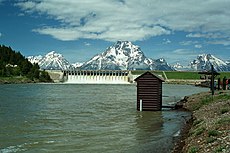| Jackson Lake Dam | |
|---|---|
 Looking west in June 1997 from the north shore of the Snake River | |
| Location | Teton County, Wyoming, in Grand Teton National Park |
| Coordinates | 43°51′27.53″N 110°35′22.54″W / 43.8576472°N 110.5895944°W |
| Construction began | 1911 |
| Opening date | 1916 |
| Operator(s) | U.S. Bureau of Reclamation |
| Dam and spillways | |
| Type of dam | Concrete gravity with earth embankment wings |
| Impounds | Snake River |
| Height | 65 ft (20 m) |
| Length | 4,920 ft (1,500 m) |
| Width (crest) | 24 ft (7.3 m) |
| Width (base) | 72 ft (22 m) |
| Spillway type | gated overflow |
| Spillway capacity | 8690cfs at 6790 ft |
| Reservoir | |
| Creates | Jackson Lake |
| Total capacity | 847,000 acre-feet (1.045 km3) |
| Catchment area | 1,824 sq mi (4,720 km2) |
 | |
Jackson Lake Dam is a concrete and earth-fill dam in the western United States, at the outlet of Jackson Lake in northwestern Wyoming. The lake and dam are situated within Grand Teton National Park in Teton County.[1] The Snake River emerges from the dam and flows about eight hundred miles (1,300 km) through Wyoming, Idaho, Oregon, and Washington to its mouth on the Columbia River in eastern Washington.
The chief purpose of the dam is to provide water storage for irrigation in the Snake River basin in the state of Idaho as part of the Minidoka Project. Jackson Lake is a natural lake, but its depth was increased by the dam to provide water storage.
- ^ Horsley, Lynn (May 9, 1983). "Jackson Lake Dam". Lewiston Morning Tribune. Associated Press. p. 8B.

